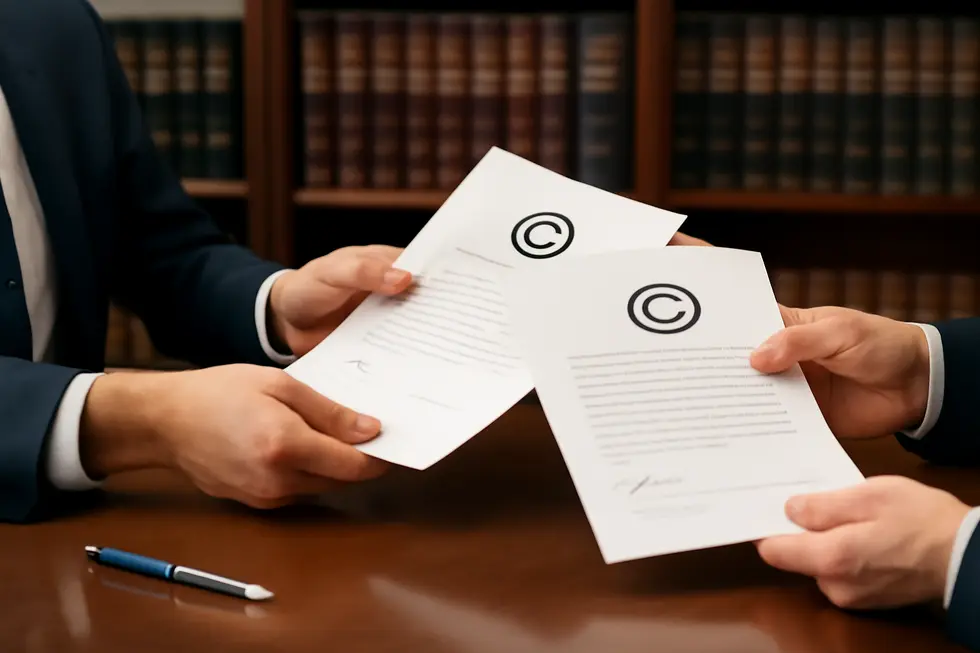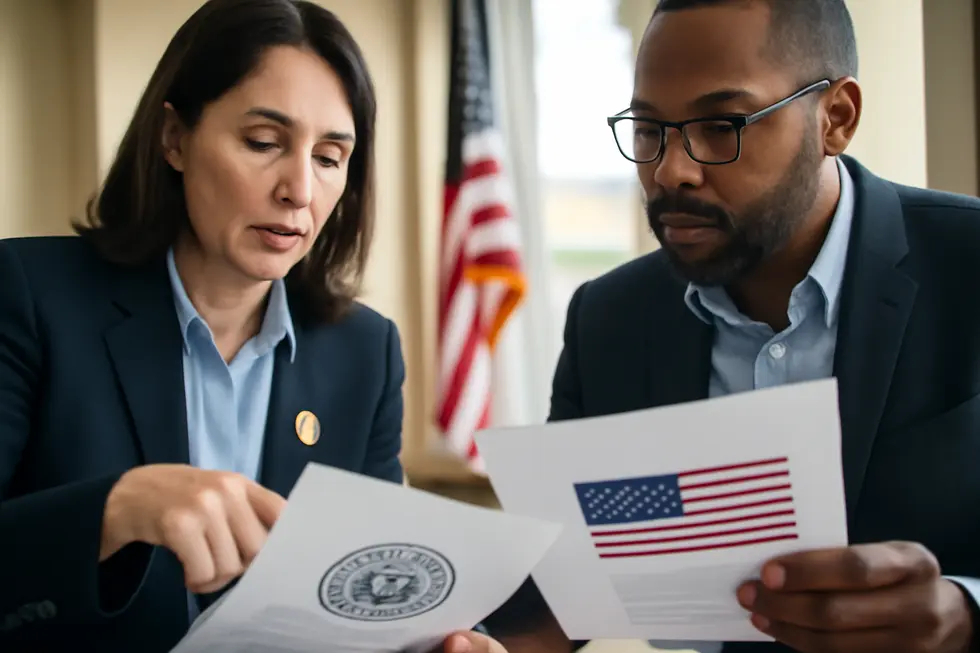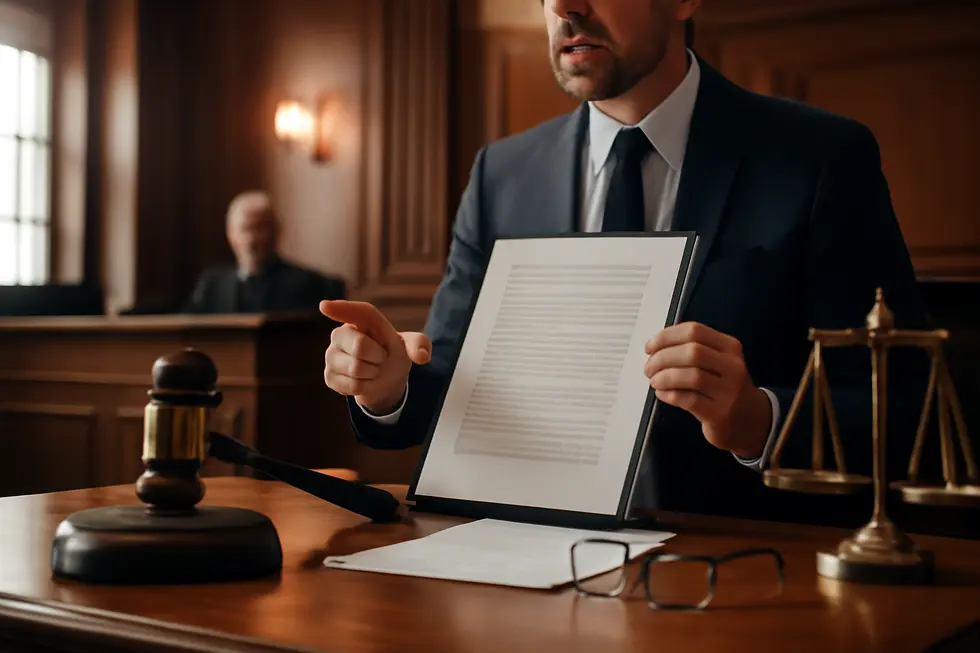Introduction
Contracts form the backbone of every business relationship, but not all contracts are created equal when it comes to copyright protection. Understanding how and when to copyright a contract can safeguard your unique and creative legal language, ensuring your intellectual property remains secure. From grasping the fundamentals of copyright application to navigating the nuances of ownership, transfer, and the special circumstances involving government contracts, this resource equips business owners to make informed decisions. Finally, we explore practical strategies to enforce and protect your copyrighted contract language, ensuring your competitive edge remains intact.
Tables of Contents
Chapter 1: Understanding Copyright and Its Application to Copyright a Contract
- How Originality and Fixation Define Copyright Protection in Contractual Language
- Defining the Boundaries: How Copyright Protects Creative Expression Within Contracts
- Navigating Ownership and Rights Management in Contract Copyrights
- Navigating Use, Licensing, and Registration to Secure Contract Copyrights
Chapter 2: Ownership and Transfer of Copyright in Copyright a Contract
- Foundations of Initial Copyright Ownership and Its Legal Framework in Contractual Works
- Essential Contractual Strategies for Defining and Transferring Copyright Ownership in Contracts
- Navigating Copyright Rights and Transfers in Government Contracts
- Navigating Reversion and Inheritance: Lifecycles of Copyright Ownership in Contractual Agreements
Chapter 3: Work Made for Hire Doctrine and Copyright a Contract
- Navigating Legal Principles Behind Work Made for Hire in Copyright Contracts
- Key Contractual Clauses That Define Ownership and Rights in Work Made for Hire Agreements
- Economic Impact of Work Made for Hire and Copyright Contracts on Creative Industry Dynamics
- Navigating Societal Shifts and AI Innovations in Work Made for Hire Contracts
Chapter 4: Government Contracts and Copyright a Contract: Regulations and Permissions
- Navigating Copyright and Data Rights within the Federal Acquisition Framework
- Navigating Contractor Intellectual Property Rights and Government Licensing in Federal Agreements
- The Bayh-Dole Act’s Role in Shaping Ownership and Rights in Government Contracted Innovations
- Navigating Public Access and Licensing Mandates in Government Contract Copyrights
Chapter 5: Enforcement and Protection Strategies for Copyright a Contract
- Harnessing Digital Tools and Online Compliance to Safeguard Contractual Copyrights
- Balancing Costs and Market Dynamics in Enforcing Copyright for Contracts
- Navigating Cross-Border Complexities: Geopolitical Challenges in Enforcing Contract Copyrights
- Navigating Ethical, Cultural, and Access Challenges in Copyright Contract Enforcement
Chapter 1: Understanding Copyright and Its Application to Copyright a Contract

1. How Originality and Fixation Define Copyright Protection in Contractual Language
Originality and fixation are the pillars determining copyright protection, even for contracts. Originality means that the contract’s language must be independently created by the author and include at least a minimal degree of creativity. Mere standard clauses or boilerplate wording, lacking creative input, do not qualify. This principle ensures that only unique expressions within contracts are protected, not the underlying legal ideas or facts.
Fixation requires that these original expressions be recorded in a tangible form, such as written or electronically stored documents. Without fixation, there is no copyright because ideas alone are not protected—only their concrete expression is.
When applying these concepts to contracts, it becomes clear that only those parts containing genuinely creative and fixed wording can be copyrighted. The author initially holds these rights unless a contract explicitly transfers or assigns them, such as under a work-made-for-hire agreement. This understanding is crucial for anyone drafting, licensing, or enforcing contracts involving copyrighted text.
For deeper insights, the University of Michigan’s guide on originality offers a valuable resource: https://guides.lib.umich.edu/copyrightbasics/copyrightability
2. Defining the Boundaries: How Copyright Protects Creative Expression Within Contracts
Copyright protection grants creators exclusive rights over original works fixed in tangible form, including unique language within contracts. While typical contracts as legal instruments lack copyright because they are functional and standard, contracts that feature creative, original text can enjoy protection over that distinct expression. These rights include reproduction, distribution, public display, and creation of derivative works, automatically vesting in the author unless transferred or classified as a “work made for hire.” Within licensing contracts, specifying the scope of protection is vital—detailing the rights granted, territorial limits, duration, and permissible modifications to control use and preserve ownership. However, these rights coexist with exceptions such as fair use. Navigating this balance ensures that intellectual property embedded in contracts is safeguarded while permitting lawful use. For complex government contracts, established rules like the Federal Acquisition Regulation outline special conditions for asserting copyright claims. A deeper understanding of these boundaries is essential for effectively managing and protecting any original contractual language. More on government contract guidelines is accessible at FAR Subpart 27.4.
3. Navigating Ownership and Rights Management in Contract Copyrights
Copyright ownership begins with the original author who holds exclusive rights to their creative work. In the context of contracts, this means that the unique text or original language within a contract is protected automatically upon creation. Ownership can, however, be transferred entirely through explicit written agreements, where the original author relinquishes all rights and grants full control to another party. Licensing offers a flexible alternative, allowing the copyright holder to authorize others to use the work under specific terms without surrendering ownership. Publishing agreements commonly govern these transfers or licenses, outlining who controls reproduction, distribution, or adaptation rights. Even when rights are assigned, moral rights—such as attribution and protection against derogatory changes—usually remain with the creator. Mastery of these principles ensures clear control over contractual content and protects original expressions from unauthorized use. For further insight into managing contractual rights, exploring formal agreements in commercial and academic publishing provides practical examples. More detailed guidance on federal contracts’ copyright-related provisions is available in the Federal Acquisition Regulation Subpart 27.4 accessible at https://www.acquisition.gov/far/subpart-27.4.
4. Navigating Use, Licensing, and Registration to Secure Contract Copyrights
Copyright in contracts extends beyond mere ownership of original text; it relies heavily on clear frameworks for use, licensing, and registration. While copyright protection arises automatically once a contract containing original language is fixed in a tangible form, registration with the U.S. Copyright Office strengthens enforcement options by allowing statutory damages and legal fees in infringement actions. Licensing plays a central role in controlling how others utilize copyrighted contract language, requiring precise agreements that specify the scope, duration, and terms under which the work may be used. Without such clear contracts, unauthorized use can lead to legal conflict. Understanding the nuances of permitted use—whether through direct ownership or license—is crucial to avoid infringement. Effective management of these elements helps creators and owners safeguard their rights, monetize their works, and maintain control over proprietary contract expressions. For more on securing intellectual property rights, exploring guidance like the Federal Acquisition Regulation Subpart 27.4 is advisable. [https://www.acquisition.gov/far/subpart-27.4]
Chapter 2: Ownership and Transfer of Copyright in Copyright a Contract

1. Foundations of Initial Copyright Ownership and Its Legal Framework in Contractual Works
Copyright ownership in contracts arises the moment original content is fixed in a tangible form, automatically vesting in the creator. This foundational principle grants the creator exclusive rights to control and use the original expression without the need for formal registration, although registration is necessary to enforce rights through federal litigation. U.S. copyright law, rooted in the Constitution and codified in Title 17 of the United States Code, protects the expression of ideas rather than the ideas themselves, underscoring the distinction critical to contracts. When contracts incorporate uniquely crafted language, this original material may be separately owned and subject to transfer or licensing through explicit, signed agreements. Such contracts, commonly known as copyright contracts, allow authors or creators to assign or license rights to others, like publishers or commissioning parties, thereby managing usage and distribution. Understanding these principles ensures clear recognition of who holds rights initially and how those rights can be legally transferred or retained. For further guidance on navigating copyright ownership in complex contracts, including those under federal regulation, consult authoritative resources such as the Federal Acquisition Regulation (FAR) Subpart 27.4.
2. Essential Contractual Strategies for Defining and Transferring Copyright Ownership in Contracts
Effective ownership and transfer of copyright within contracts hinge on clear, detailed legal agreements that define rights and responsibilities of all parties involved. Copyright transfer agreements explicitly assign ownership from creators to assignees, often publishers or employers, solidifying control over the work’s reproduction and distribution. These contracts must outline not only ownership but also specify usage terms, derivative work rights, and any possibilities for modification or sublicensing. Importantly, U.S. law provides authors the statutory right to reclaim transferred copyrights after a fixed period, reinforcing the need for precise contract language covering termination and reversion rights. In contexts such as government procurement, contracts demand tailored clauses to clarify ownership between contractors and the government, ensuring negotiated rights over software or documentation. Technology transfer agreements further exemplify comprehensive frameworks, detailing scope, duration, milestones, and restrictions to protect interests and ensure lawful assignments. Overall, meticulous contract drafting is paramount to managing copyright ownership and transfer, minimizing disputes and aligning legal control with intended usage. For detailed legal guidance, the Federal Acquisition Regulation (FAR) Subpart 27.4 offers authoritative direction on copyrights in federal contracts.
3. Navigating Copyright Rights and Transfers in Government Contracts
Navigating Copyright Rights and Transfers in Government Contracts involves understanding unique legal provisions that protect both the government’s and contractors’ interests. Under the Federal Acquisition Regulation (FAR) Subpart 27.4, contractors creating copyrighted works during government contracts must secure permission from contracting officers before asserting copyright claims, ensuring government access and use rights. While contractors generally retain the right to publish scholarly articles derived from contract work without prior approval, any transfer or assignment of copyright requires a clearly written and signed agreement explicitly defining the rights involved. Additionally, long-term contracts must consider statutory termination rights allowing authors or heirs to reclaim copyrights transferred earlier. Precise documentation of such agreements, including details on the specific works and transferred rights, is crucial for enforceability. These provisions balance intellectual property protections with public interest, underscoring the importance of legal clarity when handling copyrights in government-related contracts. For further regulatory details, see the Federal Acquisition Regulation (FAR) Subpart 27.4.
4. Navigating Reversion and Inheritance: Lifecycles of Copyright Ownership in Contractual Agreements
Reversion rights and inheritance play pivotal roles in the lifecycle of copyright ownership within contracts. Reversion rights allow authors to reclaim copyrights or specific rights after conditions like a statutory period or a work’s out-of-print status. Under Section 203 of the U.S. Copyright Act, these rights exist despite prior contracts, enabling authors to regain control of their original work. In contrast, inheritance transfers copyright ownership upon an author’s death to their heirs under property laws, distinct from contractual provisions. Contracts often incorporate clauses defining initial ownership, granting scope, duration, and possible reversion terms, carefully balancing author and assignee interests. While reversion focuses on the living author’s ability to reclaim rights, inheritance concerns the posthumous transfer of ownership, ensuring copyrights remain property that can pass legally. Understanding these mechanisms is essential for drafting or negotiating contracts safeguarding long-term rights. For more detailed guidance, resources like Columbia Law School’s termination of transfer rights guide offer comprehensive legal insight.
Chapter 3: Work Made for Hire Doctrine and Copyright a Contract

1. Navigating Legal Principles Behind Work Made for Hire in Copyright Contracts
The Work Made for Hire doctrine is a pivotal element in copyright law, delineating ownership of works created in employment or through commissioned contracts. When an employee produces a work within their job scope, the employer automatically holds the copyright, reflecting the law’s recognition of the creator’s role in an organizational context. For independent contractors, this default ownership lies with the creator unless a written agreement explicitly designates the work as a “work made for hire.” Such contracts must clearly specify the parties involved, the rights granted including usage and duration, and governing laws to avoid ambiguity. Distinctions between copyright agreements and assignment agreements further influence control and rights retention, with the latter generally involving full and permanent transfer of rights. Real-world applications illuminate these principles; for example, a magazine owning photographs taken by its staff photographer contrasts with commissioned photographers requiring explicit agreements for copyright transfer. This legal framework emphasizes how contracts serve as essential tools to establish, confirm, and enforce copyright ownership, ensuring clarity and protecting all parties’ interests. For deeper regulatory insight, the FAR Subpart 27.4 offers authoritative guidance on copyrights under federal contracts (https://www.acquisition.gov/far/subpart-27.4).
2. Key Contractual Clauses That Define Ownership and Rights in Work Made for Hire Agreements
Clear and precise contractual clauses are vital in agreements involving the Work Made for Hire doctrine to establish copyright ownership unequivocally. When works are created by employees within their employment scope, the employer automatically owns the copyright, but for commissioned works, an explicit written clause is essential to designate them as works made for hire. Such agreements must specify essential elements: a thorough identification of the work and parties involved; a detailed transfer or license of rights outlining scope, duration, and territories; payment terms clarifying compensation or royalties; usage limits restricting modification or distribution; termination conditions defining how agreements can end and their aftermath; and governing law provisions to resolve disputes. For software source code, contracts need to delineate whether the creator is an employee or independent contractor, as default ownership rules differ significantly. Unlike licenses that may be temporary, copyright assignments usually imply permanent rights transfer, demanding careful drafting. These tailored clauses prevent ambiguity and safeguard ownership interests, especially when original contract language or creative output demands protection. For authoritative guidance and practical contract templates, see the University of Michigan Copyright Basics FAQ.
3. Economic Impact of Work Made for Hire and Copyright Contracts on Creative Industry Dynamics
The Work Made for Hire (WMFH) doctrine significantly shapes economic outcomes in creative industries by assigning copyright ownership primarily to employers rather than individual creators. This centralization of economic rights can streamline revenue flow but may reduce individual incentives for innovation. For creators who are freelancers or independent contractors, copyright defaults to them unless contracts explicitly transfer ownership to clients. Thus, carefully drafted contracts are vital to clearly define rights and profit sharing, minimizing disputes and fostering cooperation. Given the high fixed costs and low marginal costs of reproducing digital creative works, ownership and contract terms heavily influence who benefits economically from scalable content. Efficient management of intellectual property rights via WMFH arrangements and explicit copyright agreements facilitates commercialization, investment, and sustainable value capture in creative sectors. For further clarity on drafting effective agreements, consulting resources on trademark and intellectual property protections can be beneficial. More details on federal contract copyrights can be found in the Federal Acquisition Regulation at https://www.acquisition.gov/far/subpart-27.4.
4. Navigating Societal Shifts and AI Innovations in Work Made for Hire Contracts
The work made for hire doctrine adapts continually under societal evolutions and advancing technologies, fundamentally reshaping copyright ownership in contracts. Traditional employer-employee dynamics still influence ownership, yet the rise of independent contractors prompts nuanced legal scrutiny to distinguish who qualifies as an employee or contractor. Employment agreements now explicitly assign intellectual property rights to clarify ownership amid diverse work arrangements. Simultaneously, the integration of AI tools challenges conventional authorship concepts, requiring contracts to specifically address AI-assisted creations and establish ownership clearly. Employers often claim copyright over AI-generated works to prevent ambiguity. This convergence of changing work models and technology mandates that contracts meticulously specify rights, control, and obligations regarding both human and AI contributions. Addressing these developments in copyright contracts ensures protection of interests and legal certainty in an evolving creative landscape. For further guidance on ownership distinctions in contract drafting, consult resources like the Community for Creative Non-Violence v. Reid ruling.
Chapter 4: Government Contracts and Copyright a Contract: Regulations and Permissions

1. Navigating Copyright and Data Rights within the Federal Acquisition Framework
Government contracts operate under a strict regulatory environment primarily shaped by the Federal Acquisition Regulations (FAR) and its supplements. These regulations define the government’s rights to use and disseminate data and copyrighted materials created during contract performance, balancing contractor intellectual property protections with public interests. Typically, the government obtains a paid-up, nonexclusive license to use data produced under the contract, including the right to reproduce and prepare derivative works. However, computer software developed with private funds is subject to restricted rights, limiting government use and distribution unless otherwise negotiated. Contractors must mark deliverables with proper copyright notices and acknowledge government sponsorship, ensuring transparency of ownership and permissions. Moreover, recent policies like Executive Order 14332 have blurred distinctions between grants and contracts by introducing contract-like terms into grant agreements, influencing how intellectual property rights and compliance are handled. Understanding these frameworks is crucial for managing copyright within government contracts and aligns with ensuring innovation while safeguarding proprietary content. For authoritative details, refer to the FAR Subpart 27.4.
2. Navigating Contractor Intellectual Property Rights and Government Licensing in Federal Agreements
In government contracts, the protection and use of copyrighted materials hinge on a carefully balanced framework defined primarily by the Federal Acquisition Regulation (FAR) and its supplements. Contractors retain rights to original works developed under private expense but must adhere to specific obligations concerning technical data created with federal funds. FAR Subpart 27.4 mandates the delivery of such federally funded technical data to ensure the government’s future acquisition capabilities. Meanwhile, commercial data related to products or processes remains largely protected, provided only essential data for operation or maintenance is disclosed. When software is involved, DFARS Subpart 227.72 governs the licensing terms, allowing contractors to restrict government use while enabling negotiations for expanded rights if necessary. Contracting officers play a pivotal role in maintaining fairness and enforcing these provisions, supported by a structured dispute resolution mechanism under the Contract Disputes Act of 1978. This system ensures contractors’ rights are recognized while securing the government’s interests in intellectual property. For detailed regulatory texts and guidance, consult the Federal Acquisition Regulation at https://www.acquisition.gov/far/subpart-27.4.
3. The Bayh-Dole Act’s Role in Shaping Ownership and Rights in Government Contracted Innovations
The Bayh-Dole Act fundamentally influences government contracts by granting contractors ownership of inventions developed with federal funding while allowing the government to maintain critical oversight. Contractors must disclose any federally funded inventions promptly and decide whether to retain patent rights, subject to government nonexclusive licenses and potential “march-in rights.” These rights enable the government to intervene if commercialization or reporting obligations are unmet, ensuring public benefit from federally supported research. Although the Act primarily governs patents, government contracts often include clauses addressing intellectual property more broadly, including copyrights in data and software delivered under the contract. Contractors must comply with these terms and ensure that subcontractors do the same, maintaining detailed records and meeting disclosure requirements to avoid enforcement actions. This legal framework balances contractor innovation ownership with government protections, reinforcing responsibilities in government contracts related to intellectual property management. More insights into government intellectual property regulations are available via regulatory investigations and enforcement resources.
4. Navigating Public Access and Licensing Mandates in Government Contract Copyrights
Government contracts impose specific public access and licensing requirements that delicately balance the government’s rights with the contractor’s copyright ownership. Under policies like the 2022 “Nelson” Memo, taxpayer-funded research must be made immediately publicly accessible, with agencies such as the NIH enforcing access starting July 2025. Contractors typically retain copyright but grant the government a royalty-free, nonexclusive, irrevocable license to use, reproduce, and disseminate the work. For data and software produced under these contracts, the government secures restricted or negotiated rights defining how it may use, modify, and disclose such materials. Security provisions also restrict access to classified information based on contract terms. Moreover, contracts often allow negotiation of rights reversion or open access licensing under frameworks like Creative Commons. The Federal Acquisition Regulation (FAR) Subpart 27.4 clarifies that while the government obtains broad licenses for data, software distribution rights to the public are carefully limited unless explicitly negotiated. This regulatory framework ensures public availability of government-funded outputs, protects classified materials, and secures clearly defined licensing arrangements that respect contractor ownership. For further details on licensing rights for data under federal contracts, see FAR Subpart 27.4.
Chapter 5: Enforcement and Protection Strategies for Copyright a Contract

1. Harnessing Digital Tools and Online Compliance to Safeguard Contractual Copyrights
Protecting copyrighted language within contracts demands advanced technological enforcement paired with strategic online compliance. Automated monitoring systems utilize AI to scan websites, social media, and digital marketplaces, flagging unauthorized replications of original contract text swiftly. Collaboration with major platforms facilitates prompt removal of infringing content via formal takedown procedures under frameworks like the Digital Millennium Copyright Act (DMCA). These legal mechanisms require precise notifications, ensuring compliant platforms act swiftly to avoid liability. Since enforcement varies globally, coordinated cross-border strategies are essential, supported by private coalitions sharing intelligence to bridge jurisdictional gaps. Internally, organizations benefit from clearly assigned responsibilities and routine intellectual property audits to safeguard their creative contract elements. Encryption and restricted access further protect sensitive contractual materials from unauthorized use or theft. For those licensing or transferring contract templates, explicit written agreements remain critical to preserving copyright. For deeper insights into navigating trademark and digital marketplace challenges alongside copyright protections, visit trademark2go.com.
External guidance on DMCA and digital enforcement can be found at https://www.acquisition.gov/far/subpart-27.4.
2. Balancing Costs and Market Dynamics in Enforcing Copyright for Contracts
Enforcing copyright over original contract language entails a delicate economic balance between the costs of protection and the benefits it yields. Legal expenses, monitoring, and administrative efforts represent significant investments that must be weighed against increased revenues from licensing and enhanced market confidence. Efficient enforcement bolsters innovation by providing creators with confidence in their rights, which encourages the development of unique contract templates and creative clauses. This legal certainty also protects consumers from counterfeit or unauthorized reproductions, enhancing overall market trust and quality.
However, overly aggressive enforcement can backfire, limiting access through high licensing fees or restricting competition, which may stifle innovation and market fluidity. Effective strategies therefore rely on nuanced economic mechanisms: signaling quality and authenticity, fostering brand loyalty, and leveraging strategic licensing to stimulate collaboration and diversified revenue streams. At the same time, respecting fair use principles ensures public interests are preserved, promoting innovation without compromising rights holders’ control. Ultimately, a well-calibrated enforcement approach maximizes economic value while maintaining market vitality.
For further insight on managing IP enforcement costs, explore practical strategies at Trademark2Go. More detailed economic perspectives can be found via the U.S. Copyright Office Fair Use Index.
3. Navigating Cross-Border Complexities: Geopolitical Challenges in Enforcing Contract Copyrights
Enforcing copyright and contract protections internationally demands careful navigation of geopolitical complexities. Diverse legal frameworks often conflict, with countries like China and the EU imposing markedly different data privacy and IP laws. These discrepancies complicate compliance and enforcement for entities operating globally. Heightened geopolitical tensions may restrict access to corporate information, undermining transparency crucial for contract monitoring and copyright enforcement. International cooperation plays a vital role; organizations collaborate to combat corruption and align enforcement mechanisms despite shifting national interests. Given the globalization of local legal risks, companies must integrate geopolitical risk assessments into governance to anticipate disruptions impacting copyrights and contractual obligations. Continuous vigilance, combined with strategic alliances across jurisdictions, strengthens protection efforts in this fragmented legal landscape. For further regulatory guidance concerning federal contract copyrights, consult Federal Acquisition Regulation Subpart 27.4.
4. Navigating Ethical, Cultural, and Access Challenges in Copyright Contract Enforcement
Navigating Ethical, Cultural, and Access Challenges in Copyright Contract Enforcement
Enforcement of copyright in contracts demands careful attention to ethical, cultural, and access concerns. Ethically, it requires respect for creators’ rights while guarding against misuse, such as wrongful takedown claims that may restrict educational or legitimate content. Transparency in enforcement practices builds trust and fairness among all parties. Culturally, copyright norms vary worldwide; enforcement strategies should accommodate these differences rather than imposing uniform standards, ensuring fairness across diverse intellectual property traditions. Access challenges arise because strict protections can limit vital educational and research materials. Fair use provisions serve as critical safeguards, enabling limited use for scholarship and teaching without undermining creators’ rights. Institutions like libraries play a crucial role in balancing these interests, applying fair use carefully to maintain equitable information access. Successful enforcement strategies integrate legal rigor with cultural sensitivity and fair use to uphold creators’ rights while promoting broader public benefit. For further insights on fair use, see copyright.gov/fair-use.
Final thoughts
Protecting the originality embedded in your contracts is a subtle yet vital aspect of securing your business’s intellectual property. By understanding when and how copyright applies to contract language, ensuring proper ownership and transfer procedures, and navigating special doctrines like ‘work made for hire,’ you create a robust foundation for safeguarding your legal assets. In government contracting contexts, adhering to regulatory permissions further strengthens your protections. Ultimately, enforcement strategies centered on originality and clear documentation are crucial for defending your rights against unauthorized use. Embracing these principles empowers business owners to protect the unique language that defines their agreements and business identity.
Your IP is the foundation of your success – let’s protect it together before it’s too late. We can’t wait to help you turn your ideas into legally secured assets.
About us
undefined


